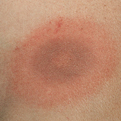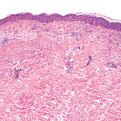Fixed Drug Eruption
General Information
Fixed Drug Eruptions take place each time a particular drug is taken by an individual and a skin reaction occurs on the same place of the body. The rash is very pruritic or may burn at first, it will then erupt as a raised dusky red or purple-tinged patch of skin (plaque), some blistering may also occur. These skin reactions usually arise on the hands, feet, lips or genitalia. Repeated exposure to the offending drug may cause new lesions to develop in addition to “lighting up” the older hyperpigmented lesions. A delay of around two weeks may occur from the initial exposure of the drug. The main goal of treatment is to identify what drug is giving the patient these reactions and avoid them. Treatment otherwise is symptomatic. Systemic antihistamines and topical corticosteroids may be all that are required and in cases in where an infection is suspected, antibiotics and proper wound care are advised.
Epidemiology
Account for as much as 16-21% of all cutaneous drug eruptions
Etiology
Adverse reactions to medications
Pathogenesis
Offending drug is thought to function as a hapten that preferentially binds to basal keratinocytes, leading to an inflammatory response
Clinical
Round or oval, sharply demarcated erythematous/edematous plaques. center of the patch may blister or become necrotic
Histology
Interface dermatitis with vacuolar change and Civatte bodies
Bibliography
1. “Drug eruption, fixed” (Online). http://www.drhull.com/EncyMaster/D/drug_eruption_fixed.html (visited: March 17, 2008) 2. “Fixed Drug Eruptions” (Online) November 2007. http://www.emedicine.com/derm/topic1336702.htm (visited: March 17, 2008)
Download PDF
![]() Fixed Drug Eruption
Fixed Drug Eruption


